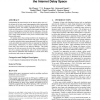Free Online Productivity Tools
i2Speak
i2Symbol
i2OCR
iTex2Img
iWeb2Print
iWeb2Shot
i2Type
iPdf2Split
iPdf2Merge
i2Bopomofo
i2Arabic
i2Style
i2Image
i2PDF
iLatex2Rtf
Sci2ools
IMC
2006
ACM
2006
ACM
Measurement based analysis, modeling, and synthesis of the internet delay space
Understanding the characteristics of the Internet delay space (i.e., the all-pairs set of static round-trip propagation delays among edge networks in the Internet) is important for the design of global-scale distributed systems. For instance, algorithms used in overlay networks are often sensitive to violations of the triangle inequality and to the growth properties within the Internet delay space. Since designers of distributed systems often rely on simulation and emulation to study design alternatives, they need a realistic model of the Internet delay space. Our analysis shows that existing models do not adequately capture important properties of the Internet delay space. In this paper, we analyze measured delays among thousands of Internet edge networks and identify key properties that are important for distributed system design. Furthermore, we derive a simple model of the Internet delay space based on our analytical findings. This model preserves the relevant metrics far better ...
| Added | 13 Jun 2010 |
| Updated | 13 Jun 2010 |
| Type | Conference |
| Year | 2006 |
| Where | IMC |
| Authors | Bo Zhang, T. S. Eugene Ng, Animesh Nandi, Rudolf H. Riedi, Peter Druschel, Guohui Wang |
Comments (0)

